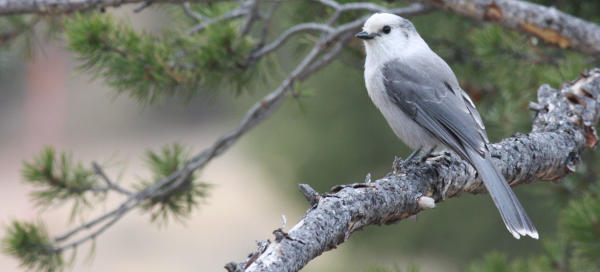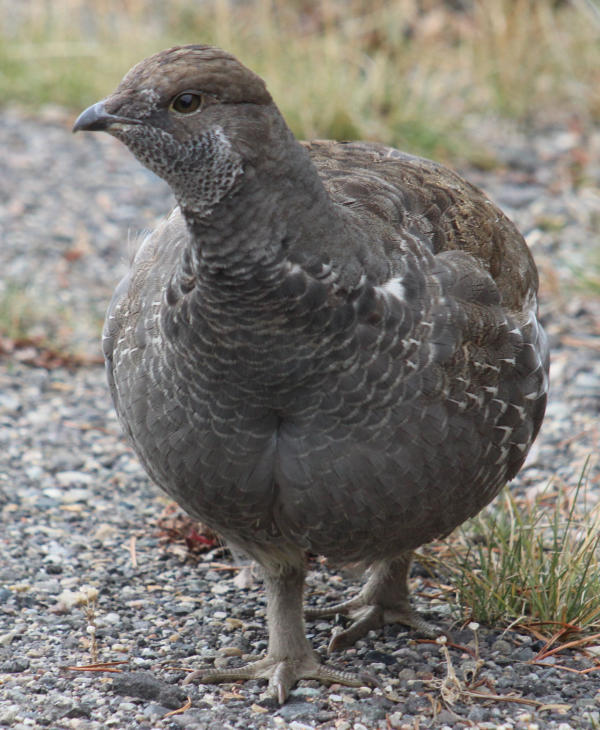
Gray Jay

Sooty Grouse
|
Every August the Northern Rocky Mountains seem to pull at my psyche more than other months. August is a time when many people take summer vacations, and the national parks in Wyoming and Montana offer a once in a lifetime trip for many people. Who can resist the iconic beauty of the Grand Teton peaks, the Yellowstone River as it flows through historic pine forests, and the tremendous scenery of Glacier National Park. For birders, there are many high-country western birds that make the Northern Rockies an even more exciting region to visit: Mountain Bluebirds and Western Tanagers, Great Gray Owls and Gray Jays, Steller’s Jays and Sooty Grouse, Spruce Grouse and Bald Eagles, and many more.
Then too, Yellowstone offers some unique geologic attractions including Old Faithful, the Grand Canyon of the Yellowstone River, Mammoth Hot Springs and many more. In addition to the birds, the big mammals of the national parks are an important part of the attraction to this region. After all, today elk are bugling, mountain goats are climbing, bison are rutting, grizzlies are feeding, bighorn sheep are grazing, wolves are howling, pronghorns are running, moose are caring for calves – it’s an exciting time to visit the Northern Rocky Mountains between Jackson Hole and Many Glaciers.
Let’s get back to birding! Like the mammals, birds are pretty widespread in the Rocky Mountains, so you need to cover some ground to get an extensive list of species. When you do encounter mountain birds, though, they are especially impressive, and I find that it’s important to spend as much time as possible with the different species to learn about their behaviors, study their plumage, and take some representative photographs. After all, who can resist spending time among such impressive birds as Golden Eagles, Trumpeter Swans, Sandhill Cranes, Black-billed Magpies, Clark’s Nutcrackers, American Dippers, Mountain Chickadees, Gray-crowned and Black Rosy Finches, Calliope Hummingbirds and Barrow’s Goldeneyes.
Glacier National Park in particular offers a few species that are tough to find in other locations: Spruce Grouse, White-tailed Ptarmigan and rosy finches to name a few. I have found a spectacular male Spruce Grouse in the high-country evergreen forests that whetted my interest to see more of this species. I’ve also seen plenty of rosy finches – they often fly overhead in small flocks in alpine areas – but I have never had a good look at them, not even a glimpse good enough to ascertain the species. Considering the range of our rosy finch species, Glacier would have Gray-crowned Rosy Finches, but you couldn’t prove it by me. And then there are ptarmigan.
I know White-tailed Ptarmigan are present in alpine areas I have hiked in Glacier. Fellow photographers have showed me photos of late-season ptarmigan they found “just up the trail yesterday;” but for me, no luck so far. That’s OK, though; that’s a part of birding, and persistence over the years will surely pay off, someday, possibly many future days. In fact, maybe I will drop everything to make a late-season trip to Glacier, just before the “Going-to-the-Sun Road” gets snowed in about October 1, with the hope of finding some ptarmigan; and grizzlies, and mountain goats and bighorn sheep and rosy finches in the alpine altitudes of the crown of America as the snow begins to fall.
It may take more than one trip to visit Grand Teton, Yellowstone and Glacier National Parks, but be careful, you may find yourself returning time and time again; and that’s a good thing!
Article and photographs by Paul Konrad
What locations lure you back for more birding excitement? Share your birding experiences with the editors of The Birding Wire at editorstbw2@gmail.com